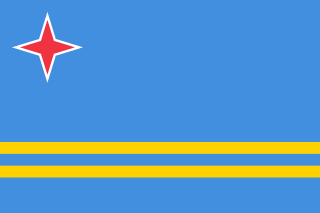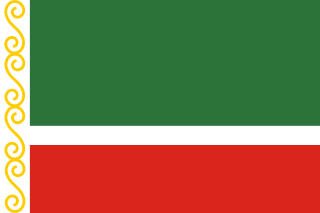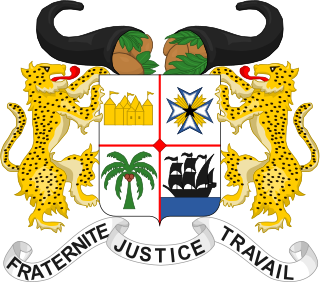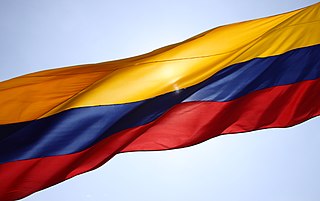
The flag of the Department of Santander is one of the symbols that identifies the Colombian Department of Santander.

The flag of the Department of Santander is one of the symbols that identifies the Colombian Department of Santander.
As the Sovereign State of Santander, the flag was the Colombian flag with the Colombian coat of arms in the center, with a red banner encircling the coat of arms that read "ESTADO SOBERANO DE SANTANDER" (es: Sovereign State of Santander). [1]
When the states were dissolved and the Department of Santander was formed the symbols were obsolete and needed to change.
In 1972, the Governor of Santander officially adopted the new flag of Santander by means of Decree No. 579 of 1972.
This flag served as the departmental flag until 2006 when it was modified by means of Decree No. 254 of 2006. The new flag would have eight stars instead of six, as in 2005, the Departmental Congress had modified the number of provinces from six to eight, and because the stars in the flag represented the provinces, the flag needed to be changed to represent its original meaning. [2]
The flag of Santander has a complicated design; it is a fimbriated horizontal bicolour triband, with a red stripe in the hoist that has eight stars.
Article 2 of Decree No. 579 of 1972 states that the flag of Santander would be a vert rectangle with two thirds the width in relation with its length, surmounted by a stripe of gules in the hoist, with a vertical line of six stars in argent. The field would be cut in the middle by a stripe of or of a quarter in width in respect to the flag, on top of this would be in the middle another horizontal stripe in sable, a third of the size of the previous stripe.
Due to the latest modifications, the stars would be eight, instead of six.

The national flag of Aruba was adopted on March 18, 1976, along with the official anthem "Aruba Dushi Tera". The flag was partially designed by vexillologist Whitney Smith. On March 18, Aruba celebrates National Anthem and Flag Day, marked by local events across the island. It is also a significant day as it represents the acceptance by the Kingdom of the Netherlands of Aruba's right to an autonomous status.

The flag of Chile consists of two equal-height horizontal bands of white and red, with a blue square the same height as the white band in the canton, which bears a white five-pointed star in the center. It was adopted on 18 October 1817. The Chilean flag is also known in Spanish as La Estrella Solitaria.

The national flag of Romania is a tricolour. The Constitution of Romania states that "The flag of Romania is tricolour; the colours are arranged vertically in the following order from the flagpole: blue, yellow, red". The flag has a width-length ratio of 2:3; the proportions, shades of colour as well as the flag protocol were established by law in 1994, and extended in 2001.

In heraldry, variations of the field are any of a number of ways that a field may be covered with a pattern, rather than a flat tincture or a simple division of the field.

The flag of Chechnya is a rectangle with sides in the ratio 2:3 representing the Chechen Republic, a republic of Russia. The flag is composed of three horizontal bars of, from top to bottom: green, representing Islam; white; and red; superimposed on them is a narrow vertical white band at the hoist, containing the national ornament, a design of four golden scroll shapes.

The flag of Bolivia is the national flag of the Plurinational State of Bolivia. It was originally adopted in 1851. The state and war flag is a horizontal tricolor of red, yellow and green with the Bolivian coat of arms in the center. According to one source, the red stands for Bolivia's brave soldiers, while the green symbolizes fertility and yellow the nation's mineral deposits.

The coat of arms or national seal of Benin, originally introduced in 1964, was readopted in 1990 after being replaced in 1975.

The national flag of Ecuador, which consists of horizontal bands of yellow, blue and red, was first adopted by law in 1835 and later on 26 September 1860. The design of the current flag was finalized in 1900 with the addition of the coat of arms in the center of the flag. Before using the yellow, blue and red tricolor, Ecuador's former flag had three light blue stripes and two white stripes with three white stars for each province of the country.The design of the flag is very similar to those of Colombia and Venezuela, which are also former constituent territories of Gran Colombia. All three are based on a proposal by Venezuelan General Francisco de Miranda, which was adopted by Venezuela in 1811 and later Gran Colombia with some modifications. There is a variant of the flag that does not contain the coat of arms that is used by the merchant marine. This flag matches Colombia's in every aspect, but Colombia uses a different design when her merchant marine ships are at sail. Along with Haiti, the Dominican Republic and El Salvador, it is one of only four national flags whose design incorporates a depiction of the flag itself.

The national flag of Egypt is a tricolour consisting of the three equal horizontal red, white, and black bands of the Egyptian revolutionary flag that dates back to the 1952 Egyptian Revolution. The flag bears Egypt's national emblem, the Egyptian eagle of Saladin, centred in the white band.

The national flag of Spain, as it is defined in the Constitution of 1978, consists of three horizontal stripes: red, yellow and red, the yellow stripe being twice the size of each red stripe. Traditionally, the middle stripe was defined by the more archaic term of gualda, and hence the popular name la Rojigualda (red-weld).

In heraldry, an ordinary is one of the two main types of charges, beside the mobile charges. An ordinary is a simple geometrical figure, bounded by straight lines and running from side to side or top to bottom of the shield. There are also some geometric charges known as subordinaries, which have been given lesser status by some heraldic writers, though most have been in use as long as the traditional ordinaries. Diminutives of ordinaries and some subordinaries are charges of the same shape, though thinner. Most of the ordinaries are theoretically said to occupy one-third of the shield; but this is rarely observed in practice, except when the ordinary is the only charge.

The coat of arms of the King of Spain is the heraldic symbol representing the monarch of Spain. The current version of the monarch's coat of arms was adopted in 2014 but is of much older origin. The arms marshal the arms of the former monarchs of Castile, León, Aragon, and Navarre.

The flag of Gran Colombia was based on Francisco de Miranda's tricolour, which served as the national flag of the First Republic of Venezuela. The general design of the Gran Colombian flag later served as the model for the current flags of Colombia, Ecuador, and Venezuela, which emerged as independent nations at the breakup of Gran Colombia in 1831.

The coat of arms of Kropyvnytskyi is one of the city's symbols reflecting its past and the controversies of its history.

The coat of arms of Antioquia, in its current form, dates back to August 23, 1812 when it was officially adopted by the Chamber of the Senate of Antioquia by means of Decree 21 of 1812, replacing the Great State Seal of Antioquia that was sanctioned by State President José María Montoya Duque on September 2, 1811. Following the incorporation of Antioquia to the United Provinces of New Granada and subsequently to the Granadine Confederation and the United States of Colombia, the Sovereign State of Antioquia adopted the coat of arms of Colombia as its state arms. Antioquia reverted to the original coat of arms in 1912 for the occasion of the centenary of the independence of Antioquia and it has been in official use ever since.

The municipality of Trabazos is located in the west of the Zamora Province, on the border with Portugal, 75 km from the provincial capital. The municipality is made of the five villages of Latedo, Nuez de Aliste, San Martín del Pedroso, Trabazos and Villarino Tras la Sierra.

The National symbols of Colombia are the symbols which represent the national identity of the Republic of Colombia as a sovereign state. The national symbols intend to represent the Colombian identity by creating visual, verbal cultural iconic representations of the national people, values, goals, and history.
Colombian military decorations date back as far as the founding of the country. An early decoration was the Cruz de Boyacá that was awarded to the generals who led their forces to victory in the Battle of Boyacá in 1819. This early decoration lives on today as an incarnation of the highest order presented by the Colombian state. There is one decoration higher, but it is only awarded for military conflicts in defence of Colombia. Other than military decorations, Colombia presents decorations on behalf of the National Government, decorations for the National Police, and decorations from the Congress of Colombia.

The flag of Cagayan is the provincial flag of Cagayan, Philippines. It is a horizontal triband of blue, gold and green, charged with the provincial coat-of-arms ringed by 29 white, five-pointed stars. It was adopted on March 11, 1970 by the virtue of Provincial Board Resolution No. 319.

The Johannesburg municipal council assumed a coat of arms in 1907, and had it granted by the College of Arms on 20 August 1907. The design, by W. Sandford Cotterill, consisted only of a shield : Vert, a fess between three battery stamps Or. The motto was Fortiter et recte.